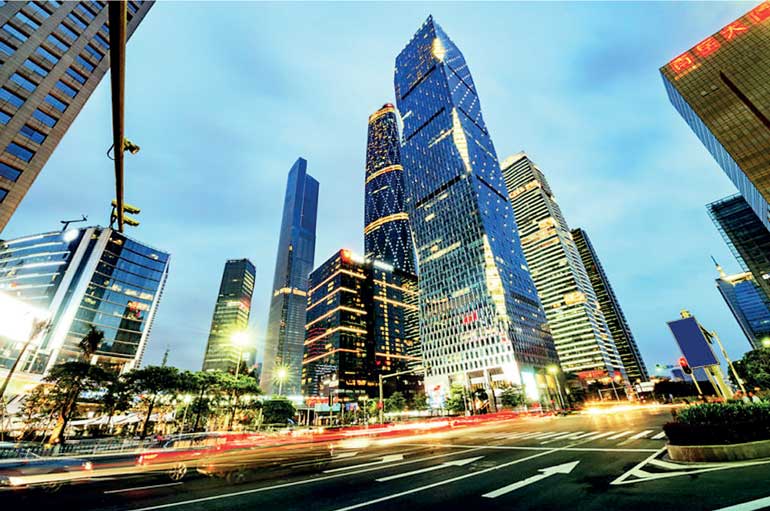Sunday Dec 14, 2025
Sunday Dec 14, 2025
Friday, 18 March 2022 00:00 - - {{hitsCtrl.values.hits}}

This year (2022) marks the 65th anniversary of the establishment of China-Sri Lanka diplomatic relations and 70th anniversary of signing the historic Rubber-Rice Pact. In view of the above, it is opportune to understand the process of China’s development and its future in the global context.
anniversary of signing the historic Rubber-Rice Pact. In view of the above, it is opportune to understand the process of China’s development and its future in the global context.
China, the most populous country, has achieved a miraculous advancement in economy, business, science and technology, and many other sectors within a relatively short period – in about 30 years. It is such an achievement which redeemed about 800 million people from poverty that mostly pro-western media have, at present, been active in the path of downplaying by way of highlighting distorted facts. In addition to its attainment as a global power, it has projected itself as a lender, trader as well as an infrastructure developer in other developing nations too.
The world was hitherto being dominated by the West with its free-market principle and it believes that it is the key to economic success. Capitalism is the tool with which the West built its economies. The more the rest of the world operates on this principle, the easier it is for capitalists to grow as they find markets to sell their goods and services while gaining cheap labour from the Third World. The Chinese model goes against this Western principle completely, with its communist ideology and state-controlled markets and trade, threatening the very foundation that the West has built its empire. Since the Chinese model is contrary to the free market economic principles of the West, China is viewed as an adversary by the West, who criticises almost all of China’s socio-political and economic aspects, specifically through Western media.
Despite the hurdles that the Western world throws to thwart China’s development path, it has managed to overcome them and emerge as a First World power and beyond in almost all fields, surpassing the West in many aspects.
The purpose of this article is to enhance awareness of modern and highly significant achievements of China.
Historical power shifts
Throughout world history, power shifts have occurred from time to time. Europe was the most powerful in the 17th century despite various power shifts that took place within it. The states of Southern Europe, specifically Spain, Portugal, and the Italian states, which reigned supreme, had to give way to new powers in the North, such as England, France, Holland, and the German states. History indicates 16 instances in the past 500 years where a rising power had been a threat to the ruling one.
In the present-day scenario, the United States of America had been a global superpower for several decades. However, the emergence of China as a global superpower is widely being discussed in scholarly circles.
China has a unique place in the world with its communist government mixed with state-led open economic policies. With a clear prediction that history shall repeat, it seems that the world will, in the near future, see another power shift with China at its centre. Although the Thucydides Trap predicts war when one great power threatens to displace another, scholars argue that this can be avoided through a strategic management of relations.
China is, at present, the world’s second largest economy and the world’s leading exporter. Its foreign aid provision and outward foreign direct investment have grown significantly over the last decade. Its economic rise is complemented by its geopolitical strength reflecting the nation’s hard power and soft power capabilities.
Wealth and economic trajectory
According to research by McKinsey & Co., China has surpassed the US to become the wealthiest nation. The research elaborates that the worldwide net worth rose to $ 514 trillion in 2020 and China accounts to nearly one-third of the increase with $ 120 trillion in 2020, emerging as the richest nation in the world. With just $ 7 trillion in 2000, China had managed to gain the top spot with a jump of $ 113 trillion in just 20 years.
China’s superpower status is also demonstrated in the IMF officially green-lighting the acceptance of the Yuan into the IMF’s foreign exchange basket. In view of this, the probability of US$ being slipped away from its status as the world’s reserve currency could also not be overemphasised.
State-owned enterprises dominate China’s economy, accounting for over 60% of China’s market capitalisation in 2019. By 2019, the total assets of all China’s state-owned enterprises reached $ 78.08 trillion where 91 of them belonged to the 2020 Fortune Global 500 companies. China has the world’s second largest economy when measured by nominal GDP, and the world’s largest economy since 2014 when measured by the Purchasing Power Parity. History proves that China too had been among the world’s foremost economic powers for most of the two millennia from the 1st until the 19th century.
While proceeding on the new economic trajectory, it is not their way to merely depend on the GDP but rather a qualitative development for its citizens. This is evidenced by Chinese President Xi Jinping’s statement in 2021 that China will move away from its previous approach of rapid growth and reform to high-quality growth and development. He said: “We must strive to promote the common prosperity of all people and achieve more obvious substantive progress. … [We must] no longer simply talk about heroes based on the growth rate of GDP.”
This is a clear indication of what China vies for in the next step of its economic trajectory, which is sustainable development that reaches all people for collective growth.
The Belt and Road Initiative (BRI) or the New Silk Road, is again another ambitious infrastructure project launched in 2013 by President Xi Jinping. The collection of development and investment initiatives would stretch from East Asia to Europe under the BRI, expanding China’s economic and political influence in the world. Investing in nearly 70 countries and international organisations, China’s infrastructure investments include ports, skyscrapers, railroads, roads, bridges, airports, dams, coal-fired power stations, and railroad tunnels.
Gross Domestic Product
Although President Xi Jinping clearly indicated the nation’s shift from emphasis on GDP, its achievements in the recent past in GDP needs special mention.
China has succeeded in surpassing the GDP of the European Union for the first time in history in 2021. This was a year earlier than previously estimated, according to the EU. China beat market expectations with an 8.1-percent-growth for 2021, and GDP reaching 114.37 trillion yuan ($ 18 trillion).
Analysts say that this achievement reflected the Chinese economy’s resilience despite the global pandemic and China’s effective epidemic control policies. It also shows China’s advancement in a wide range of sectors from new-energy vehicles and artificial intelligence to cloud computing and Internet of Things in recent years, eclipsing the EU which lacks such strengths.
China also has the largest foreign currency reserves with over two and a half times more than the second-largest reserve holder, Japan. When China and Hong Kong reserves are considered together, the total is $ 3.87 trillion.
Geopolitical strategy and international relations
China’s geopolitical strategy and influence span out under its Belt and Road Initiative, its role within the UN and other bilateral and multilateral relations, along with international aid.
China projects its external relations as its international cooperation strategy to enhance global connectivity, communication and cooperation, to foster a more balanced and equitable world system and a strategy of peaceful development. The BRI has propelled concrete and steady achievements in infrastructure building, trade and investment promotion, joint construction of industrial parks and free trade zones, financial cooperation and cultural exchange that contribute to economic and social progress of both China and cooperating countries. It welcomes all willing countries, including the United States to participate.
China considers it to be an agent for South-South cooperation, assisting countries that need the most aid. Between 2013 and 2018, China’s annual average spending on foreign assistance reached approximately $ 7.0 billion, growing by almost 50% compared to 2010-2012. Most of China’s assistance of 45% goes to African countries, followed by Asia and Latin America with 37% and 7% respectively. China’s assistance similar to the Official Development Assistance (ODA) in 2019 was estimated at $ 5.9 billion, making China the sixth largest provider of ODA.
The multilateral commitments in helping other nations are a conspicuous component of the development program of China. It is evidenced by the assistance to other nations in controlling the Covid 19 pandemic. China donated $ 3 billion and $ 30 million to the WHO on top of the $ 20 million in March in 2020 to support its global fight against COVID-19. China’s cash donations to the WHO are apart from other donations to nations in the form of cash, medical equipment and vaccines. By 7 February 2022, China had sold 1.69 billion, donated 174 million, and delivered 1.39 billion vaccine doses to the world. Although Sinopharm received a lot of flak with misconceptions surrounding it mainly generated from the Western world, China powered through with its COVID combat program, making the life-saving vaccine available with WHO support, for those most in need of it.
China’s importance as a global development partner will continue to grow, and its institutional capacities and approaches are set to develop in parallel as part of its geopolitical strategy.
China has a growing influence within the United Nations. This is due to the 350% increase of donations to the UN and related bodies over the past decade. China has increased its influence in crucial non-UN multilateral bodies as well in terms of personnel and funding, including the International Telecommunications Union (ITU) and United Nations Industrial Development Organisation (UNIDO). The mandatory contributions as a UN member rose by 1,096% between 2010 and 2019, while voluntary donations increased from $ 51 million in 2010 to $ 172 million in 2019. Such contributions can influence the way development projects are implemented.
China heads four of 15 principal agencies of the UN – ITU, UNIDO, Food and Agriculture Organisation (FAO) and International Civil Aviation Organisation (ICAO) – and Chinese deputies are present in nine of these agencies, including the World Bank, International Monetary Fund (IMF), International Maritime Organisation (IMO), United Nations Educational, Scientific and Cultural Organization (UNESCO), and World Health Organization (WHO).
Further analysis of China’s sectoral progress will be presented in a separate article.